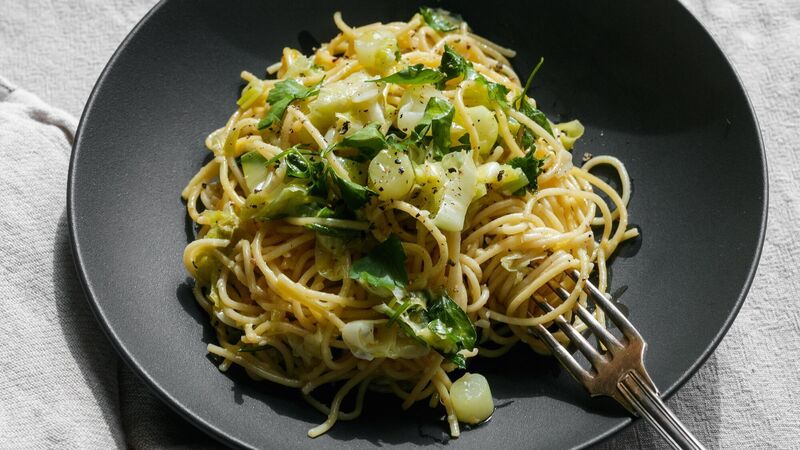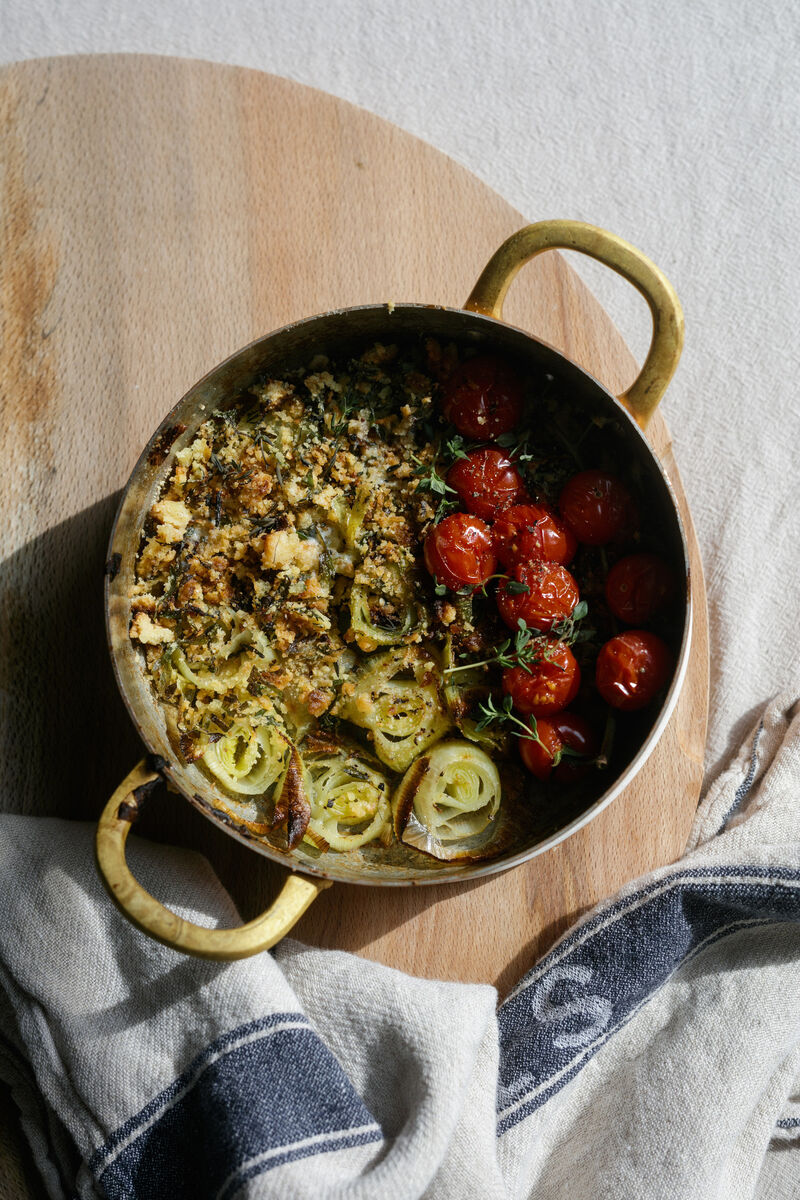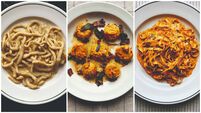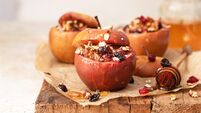The Currabinny cooks: Making the most of leeks

Creamy Leek Linguine. Photo: Bríd O'Donovan.
October can be a mixed bag. You get the first real chills of the year with frost appearing on particularly cold mornings. Rain, like always can be abundant and relentless.
The early darkening sky can make us feel like going out and about less and curling up by the fire more. October can, at times, be gentle and fine. Clear skies, fresh crisp air, dappled light still offering warmth. The leaves turn amber, yellow and deep crimson red.
Winter geese can be seen in V formation in the skies and the last swallows are fleeing South to remind us that farther to the north of our island, the ice, snow and darkness has already taken hold. The first proper frost, of course, will finish off the last of the Summer flowers still hanging on. As if overnight, the last green foliage also changes to the familiar Autumnal hues. A time of great change indeed.
We love to get outside on clear days to soak up all the brilliant colours. Breathing in that fresh, cold air makes you feel alive and strangely nostalgic as if the all too short Summer just gone had miraculously erased all memory of Winter. Walking back home to the smell of chimney smoke in the air, making you excited to collapse in front of your own blazing fire.
Our eating habits change with the seasons too. We like to hold off going too far in on the sticking to your bones comfort food but there is a definite increase in the use of cream, cheese and root vegetables. One of our favourite things at this time of year is leeks. They cannot be anything other than comforting but they also don’t have to be so heavy as to render you pot-bellied and unable to move. The time for that sort of hibernation eating is still yet to come.
From the onion family, the leek is perhaps more refined, being less sweet and more delicately subtle. Unlike onions, leeks need gentler handling and will not hold up to browning or charring. A burnt leek is utterly ruined. Leeks benefit from plenty of butter and slower, lower on the heat cooking. Things like cream, any type of hard cheese, bacon, chicken, thyme and eggs will be a leeks dream companion in a dish.
The recipes I have included here are all easy, non-fuss ways of cooking and eating leaks. Nothing too heavy but all three recipes will certainly do the job of comforting you.
A pasta dish made for this time of year. James is obsessed with linguine and won’t have any notion of spaghetti near our kitchen. Indeed, while sauces seem to slide off spaghetti, Linguine’s flatter shape allows for all of the creamy, deliciousness to cling firmly to each strand of pasta. I like to stir an egg yoke through at the end for extra decadence. You can omit this if you prefer but it does transform the dish into something special. Leeks, thyme, butter and parmesan are enough here to give you the silky, smooth texture without actually having to use cream.
Serves 4.
- 2 large leeks, green removed, whites sliced thinly
- 4 cloves of garlic, finely sliced
- 4 sprigs of thyme, leaves only
- 50g butter
- A little olive oil
- 300g linguine
- 70g parmesan, grated
- 1 egg yolk
- Sea salt and freshly cracked black pepper
Cook the linguine as per packet instructions in boiling salted water. When you have done this, drain the pasta and let it cool a little, stirring a little olive oil into it to prevent the pasta from sticking to itself. Reserve around 400ml of the pasta water.
Heat a saucepan or casserole over a medium heat and add a little oil along with the butter, letting it melt. Add the leeks, thyme leaves and garlic, letting everything soften in the heat. Be careful not to let either the leeks or garlic brown or burn in any way, turning down the heat if needed.
Add the pasta water, season lightly and partially cover the pot, letting everything simmer gently for around 40 minutes. When done, remove from the heat and add the pasta to the mixture which should have thickened a little. Add the grated cheese and egg yolk stirring it into the mixture. Make sure the mixture is not too hot or the egg will scramble.
Crack in loads of black pepper, some more thyme leaves and serve straight away.

This is a sort of swan song for the last of summer, using up some of the final glut of greenhouse tomatoes and the window sill basil. It is a good recipe for specifically this time of year as it sort of bridges the gap between the end of summer and start of Autumn. It has summery flavours but has more of the comforting elements of autumn like cream and cheese.
- 2-3 large leeks, green parts discarded, cut into thick slices
- 60g butter
- 250g cherry tomatoes on the vine
- Small handful of fresh basil leaves
- 200ml of double cream
- 250g cream flour
- 125g cold butter
- 80g hard goats cheese, grated
- A few sprigs of thyme, leaves only
- A small handful of parsley, finely chopped
Preheat the oven to 200C.
In a large bowl, rub together the flour and butter until you have a breadcrumb like consistency. Add in the cheese, thyme and parsley until you have a nice crumble. You can make this ahead and keep it covered in the fridge. Be mindful not to allow the butter get too warm and melty.
In a medium sized casserole or oven proof pan, cook the leeks in the butter over a medium heat. Allow the leek to soften but not take on any colour. Season generously with salt and freshly cracked black pepper. Lower the heat a little and add the cream and basil leaves stirring everything around for a minute or two before taking off the heat. Scatter the crumble over the creamy leeks and place the tomatoes to one side, seasoning them with a little sea salt.
Place in the oven 35 to 40 minutes until the crumble is golden brown and the tomatoes are blistering and oozing out. The cream should be bubbling up around the edges.
Serve into bowls as a lunch or eat straight from the casserole with some crusty white bread to mop up all the creamy mixture.

This is a great little side dish you can make on the stove top quickly. I like to use rolled spelt, but rolled oats or barley will of course work just the same. There is something pleasing about the silky smooth leeks contrasting with the nutty, crunchy spelt which you caramelise on a hot pan. I like to use the small to medium sized leeks if you can get them, they tend to soften better and don’t turn squeaky or rubbery like the big ones can.
- 3 medium or 4 small sized leeks, trimmed and cut into 1 inch slices
- 50g rolled spelt, barley or oat flakes
- 1 clove of garlic, crushed
- 5-6 sprigs of thyme
- 2 teaspoons of good dijon mustard
- 1 teaspoon of runny honey
- 100g butter
- Extra virgin olive oil
- Sea salt and black pepper
In a small bowl, mix together the honey, mustard and around 2 tablespoons of extra virgin olive oil with a little pinch of salt. This will be a sort of dressing to drizzle over at the end.
In a small frying pan over a medium heat, melt 50g of butter. Add the rolled spelt along with he crushed clove of garlic and a small pinch of salt. Stir everything together in the pan allowing the spelt to toast in the butter. It should take around 6 minutes. Remove the spelt from the pan, transferring it to a plate or bowl.
Melt the remaining 50g of butter on the same pan and add the leeks along with around 50mls of water, the sprigs of thyme and a pinch of sea salt and black pepper. Simmer gently for around 10 minutes until the leeks are nice and silky smooth. You want all of the liquid to either soak into the leeks or evaporate. Watch that the pan doesn’t dry out too quickly and that the leeks don’t brown or burn.
When the leeks are done transfer them to a warm serving dish, scatter over the rolled oats and drizzle generously with he dressing. You can garnish with some thyme leaves and an extra crack of black pepper.





